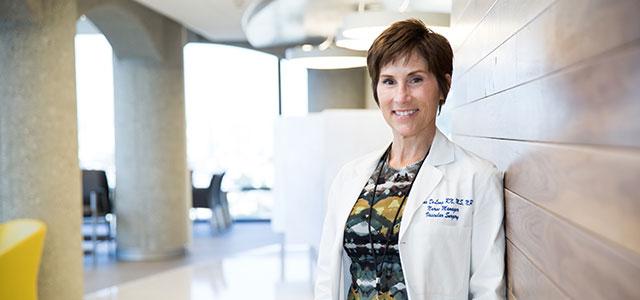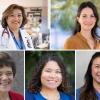
Joanna DeLong at UCSF Medical Center at Parnassus (photo by Elisabeth Fall)
Creating Opportunities for Nurse Practitioners to Help Save Limbs and More
While growing up in rural Washington, Pennsylvania, Joanna DeLong (MS ’02, ACNP ’08) would often go fishing with her family in her grandfather’s pond.
“One day, one of us caught a catfish, and my grandfather went to clean it. He picked up a knife, plunged it in, pulled out a handful of guts – and my brothers went screaming over the hill,” she laughs. “But I was fascinated. I wanted to know how it all worked.”
That good-natured, unsentimental curiosity has characterized much of DeLong’s working life. Today, she applies it to managing multiple UCSF Medical Center clinics, serving as the first point of contact for referring physicians, seeing patients and overseeing more than 40 clinicians and administrative staff, including 17 nurse practitioners.
Her path to her current role, however, was no straight line.
From Transplant to Travel and Beyond
After graduation from Duquesne University School of Nursing, she went to work at University of Pittsburgh Medical Center as a nurse in the liver transplant intensive care unit (ICU).
“It was during the ’80s nursing shortage, and I hadn’t even passed my boards yet,” she says. However, with the support of the medical center, it didn’t take her long to overcome that hurdle.
A year and a half later, nurses remained in demand, and, DeLong says, “I thought I was all that.” Encouraged by her mother to spend some time away from their small town, she signed up with a traveling nurse company and wound up working for three years at hospitals around the country, including at Highland Hospital in Oakland. She was about to take a job in Seattle when the traveling nurse agency called about a position in the cardiac ICU at UCSF Medical Center.
There, she worked her way up to assistant manager under Carla Graf (who earned her PhD at UCSF School of Nursing). “This was 1999, and my first day on the job Carla asked me what I was going to do with my future,” says DeLong, who had a vague notion of going back to school to become a dentist.
But after Graf spoke with her about advanced practice nursing, DeLong went to a School information session and became intrigued with health care informatics, something offered at the time as a master’s degree.
“It seemed like the wave of the future,” she says. She completed her degree in 2002, working closely with physician Charlie Mead, who oversaw the School’s nursing informatics program.
After succeeding Graf as manager of the cardiac ICU, DeLong eventually moved to the medical center’s IT department, where she led a team that built the nursing documentation in the first electronic medical record at UCSF. (Years later, when the medical center shifted to its current EMR implementation, DeLong would become the subject matter expert for clinicians in vascular surgery.)
But after moving on to become the Department of Nursing’s informaticist, DeLong suddenly found herself caught between two worlds.
A Career- and Life-Changing Decision
“I would ask my colleagues in IT if they missed the bedside because I was feeling the pull, but I kept thinking I would get used to this.… It was interesting, and I learned a ton,” she says.
There was also the temptation of big money, with an offer from a consulting firm that dwarfed what she could make as a nurse. Yet, as she seriously considered leaving the medical center, she ran into a colleague who helped convince DeLong that her passion was with patients.
So in 2006, DeLong rejected the consulting offer in favor of becoming a nurse manager for vascular surgery, where she began by managing the faculty practice and overseeing the outpatient clinic. The interim chief of vascular surgery encouraged her to begin hiring what would eventually become a broad roster of NPs. “The first two we hired are still here today,” she says.
Perhaps it was her contact with so many NPs, but DeLong found herself restless to pursue more education, and she enrolled in a post-master’s program at the School, where she earned her acute care nurse practitioner (ACNP) credential in 2008.
The additional credential – plus the 2012 departure of the service line director for the UCSF Heart and Vascular Center – wound up giving DeLong additional responsibilities. These include more NPs reporting to her from specialties that range from pulmonary hypertension to heart failure, electrophysiology, adult congenital heart disease and the catheter lab.
In addition, each year someone from her team precepts an acute care NP student from the School. “They see both the inpatient and outpatient side of things and get to work side by side with attending physicians,” says DeLong.
A Deep Understanding of the Value of Advanced Practice Nursing
All of this movement among various aspects of health care has only deepened her appreciation of the role that nurses and advanced practice nurses play in the system.
“Charlie Mead, who had a real appreciation for what nurses do, once told me: ‘Doctors are the nouns in health care – they name things – and nurses are the verbs; they are the action.’ With an NP, you’ve got both the noun and the verb; you’re really part of the whole continuum,” she says.
She sees that every day at UCSF’s Center for Limb Preservation, where a team of vascular surgeons, podiatrists and specially trained nurse practitioners jointly treat patients with conditions such as infections, nonhealing wounds and peripheral artery disease.
“We had an NP clinic today for all of vascular surgery,” DeLong says. One patient with a fistula was getting his sutures removed. Another with critical limb ischemia had to be seen because the incision from his amputation was bleeding.
“There are all these nuances and steps with this high-risk patient population that is very complex, medically and socially,” she says. “The NPs know these patients through the entire process: surgery through making a plan for next steps, coordinating with other specialties and helping facilitate care for patients who live too far away for frequent visits; the NPs see and manage the entire picture.”



